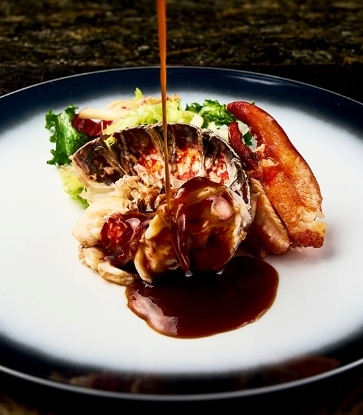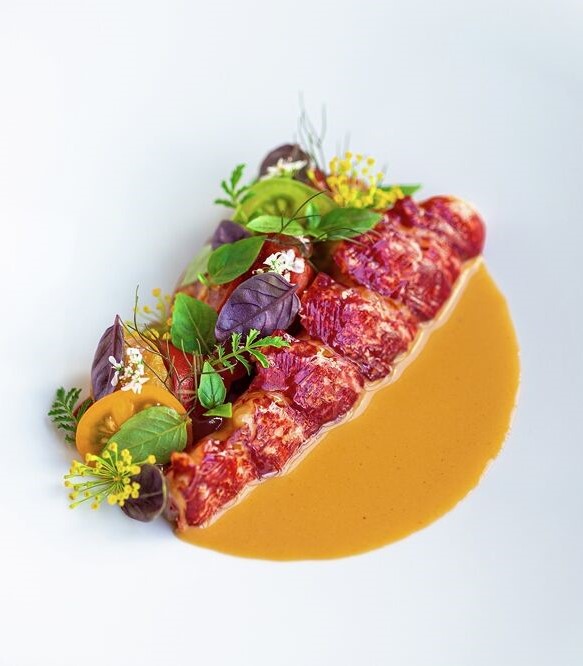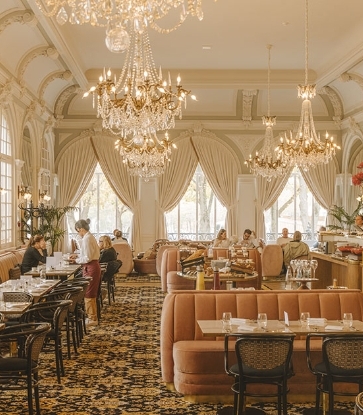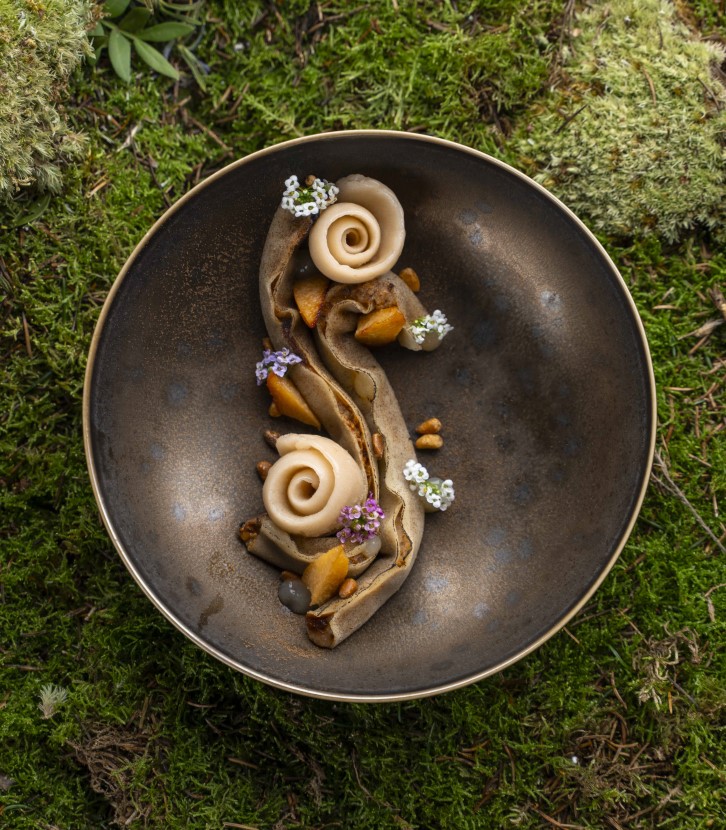For December, we are pleased to share eighteen new additions to the MICHELIN Guides to Kyoto and Osaka, ahead of the annual launch ceremonies when the MICHELIN Stars, Bib Gourmands and MICHELIN Green Stars will be unveiled.
These newly added restaurants appear on our official website and are highlighted with a ‘New’ symbol for easy identification.
December 2024
Nakamitsu breathes new life into Japanese cuisine. Guests feel at ease with Kyoto specialities at Chiso Aida. At Sokkon Fujimoto, yearly events of Japan’s ancient capital are incorporated into the menu. Takehisa adorns its cuisine with decorative leaves to convey the passing of seasons. Tokuo brings the future of Kappo culture to the next generation. Feasting on soba while gazing at gold foil paintings at Saryo Tesshin is a refined experience. Miyagawacho Tensho serves noodles from a chef who honed his skills at a ryokan inn famous for tempura. The elegance of Japan’s Showa era can be enjoyed while enjoying sushi Kappo at Kiyamachi Ran. Zucchero is a seafood Italian restaurant run by a fresh fish broker. Located in Osaka’s Nakanoshima area, Rooots Nakanoshima has its origins in French cuisine from Hiroshima. Splendours of Chinese cuisine are in full display at atelier HANADA by Morimoto. Guests can enjoy tonkatsu courses at Kyomachibori Nakamura. Sushi Enishi values the connections between people. Red and white vinegared rice are used appropriately for the sushi at Sushidokoro SHIN. At Nishitemma Ichigaya, adherents of Naniwa Kappo cuisine show their skills. Kitashinchi Gyosai Masashi is a Kappo restaurant with a lineup of à la carte items. At Sugimachi, a Japanese restaurant, careful attention is paid to ingredient combinations. Charcoal grilling techniques shine brightly at Kirari.
Kyoto
Chiso Aida
JapaneseDrawn by the elegance of Kyoto cuisine, the chef polished his skills in the city’s geisha quarter and keeps creative flourishes to a minimum. Their motto is ‘Continuity is Strength’, capturing their single-minded devotion to culinary excellence.

Nakamitsu
JapaneseThe chef is an earnest devotee of everything that makes a restaurant great, thanks to careful study of ingredients, culinary technique and attention to every customer. Knowing that the taste of dashi soup stock changes over time, the chef patiently rests his stock to draw out the flavour.

Sokkon Fujimoto
JapaneseChef devotes himself to the tea ceremony, flower arrangement and calligraphy to hone his aesthetic sense and sensitivity. Annual events in the ancient capital are woven throughout his menu, conveying venerable cultural traditions.

Saryo Tesshin
SobaSaryo Tesshin stakes its reputation on its creative soba, and indeed the ‘Daigo Soba’ is renowned. The soba is slathered in a snowfall of Parmigiano Reggiano cheese, in imitation of ‘daigo’, an early form of cheese.

Kiyamachi Ran
SushiFrom below the ledge, water flows to rinse the fingers, stirring fond memories of Showa-era times. Pickled nigiri oozes the culture of Kyoto.

Zucchero
ItalianThe menu changes daily, with an impressive lineup of seafood in season. Dishes are simple, including fare such as carpaccio, fritters and stewed tomatoes.

Miyagawacho Tensho
TempuraAn omakase feast of tempura and other delights of Japanese cuisine. Guided by his experience at a restaurant with attached inn, the chef starts the meal with sashimi and soup dishes before proceeding to tempura.

Takehisa
JapaneseSimmered items such as unripe plum simmered in sugar syrup and herring with eggplant are labours of patient love. In his early years, the chef was surrounded by the blessings of nature; in tribute to that experience, and to convey the changing seasons, he garnishes his dishes with leaves collected from the mountains.

Tokuo
JapaneseTo usher in the next generation in kappo culture, Tokuo goes all in on à la carte items.Duck meat dumplings, a heritage from the chef’s apprenticeship days, are lovingly prepared in homage to his culinary mentor.

Osaka
atelier HANADA by Morimoto
ChineseThe chef uses Chinese techniques to create a wide assortment of dishes. Foie gras pickled in Shaoxing wine with smoked daikon pickles, for example. Modern confections with a French influence and petit four sweets bring a new sensibility to desserts.

Nishitemma Ichigaya
JapaneseNishitenma Ichigaya upholds the traditions of Osaka while incorporating new influences. From time to time, French methods are employed as well. The seafood with miso sauce américain is a flavour found only here.

Kirari
JapaneseChef's omakase set menu showcases the appeal of charcoal grilling. Decoratively arranged sashimi are scorched; the coating of fried foods is broiled to wreathe them in fragrant smoke.

Sushi Enishi
SushiDashi soup stock is drawn from kombu kelp and dried bonito flakes; the addition of vegetables stems from his experience in other disciplines of Japanese cuisine. To modulate the flavours, sushi topping temperatures are varied and the tartness of citrus is used.

Rooots Nakanoshima
ContemporaryItalian fare is the base, overlaid with French influences from the flagship restaurant, resulting in a seamless blend of French and Italian recipes. Potato gnocchi is the signature dish.

Kitashinchi Gyosai Masashi
JapaneseThe cuisine runs the gamut from old-school Japanese to creative Western dishes. Grilled celery with vinegar and miso dressing, bite-sized beef cutlets and crab cream croquettes are popular year-round.

Sugimachi
JapaneseKombu kelp, dried tuna and bonito flakes dashi soup stock provide the base. Hot pots include tomatoes; chicken dashi soup stock is added to takikomi-gohan. Here, ingenious tastes are calculated to create flavours.

Sushidokoro SHIN
SushiWith an unerring eye for the nature of each fish type, he chooses red-vinegared or white-vinegared sushi rice depending on the fish. The menu interweaves side dishes and nigiri for variation, heightening guests’ sense of anticipation.

Kyomachibori Nakamura
TonkatsuA wide range of cuts, including tenderloin, shoulder and ham, are served by the slice. Multiple brands of pork loin are on offer, so you can compare the texture of the meat and how the fat melts in the mouth.

November
Kyoto
shiro
ContemporaryThe colour scheme speaks of immaculate purity. The white interior is refreshing; the blank spaces left in the arrangements bring clarity of focus.

Kyoen
ContemporaryJapanese and Italian cuisine in two-part harmony. Prix fixe menus incorporating both styles are the focus, with unique twists thrown in. A banquet that leaves nothing to be desired.

Nishijin Hashimoto
JapaneseA baseball fanatic since his youth, behind the counter the chef demonstrates the strength of will he developed on the baseball diamond. His favourite expression, then and now, is ikkyu nyukon: pour your heart and soul into every pitch.

Masumasu Masuda
JapaneseMasumasu Masuda serves trout delivered from Nikko as oshizushi, and Tochigi wagyu beef raised by a friend of the chef as cutlets. Rice cooked on a hearth is sourced in Tochigi as well.

Tsujifusa
JapaneseFusa means ‘linen’ or ‘hemp cloth’, which is used in Shinto rituals to symbolise cleanliness. The word was chosen for the restaurant’s name because, like Japanese cuisine, it developed from an origin as a sacred offering.

Kappo Umetsu
JapaneseKappo Umetsu offers an extensive list of à la carte dishes, the better to entertain diners. In a show of flexibility, staff cater to guests’ preferred preparation method—grilled, simmered, fried and much more.

Takoyakushi Furukawa
JapaneseThe meal unfolds from the drawing of dashi soup stock, ensuring that you experience the beguiling aroma and taste of the basic soup stock. The menu is extensive, presenting the flavours of the season a little at a time.

Komedokoro Inamoto
IzakayaThe proprietor loves rice, so he named his establishment ‘Komedokoro’, meaning ‘place of rice’. Taste the freshly cooked white rice and you’ll understand why it’s so famous. Dishes are served on small plates, encouraging you to try a variety of items.

Koryori Takaya
JapaneseFreshly cooked dishes and smiling conversation put diners in a good mood. For lunch, set meals with a variety of small side dishes are served; in the evening, the chef displays his talent with omakase, concluding with rice in earthenware pots and accompaniments.

Osaka
QUINTOCANTO
ItalianWhile offering perennial favourites such as Catalana of foie gras and spaghetti pomodoro, the restaurant is always conjuring new and creative menu items.

KAMINOZA
JapaneseLove of cooking, attentiveness to guests: the spirit of gratitude is etched in the restaurant’s name, which means ‘gathering of the gods’. Meticulous food preparation and attentive service say ‘thank you’ better than any words.

Ueroku wine
SpanishA Spanish restaurant by Bordeaux vintner Leo Shinohara. The chef parlays Japan’s unique seafood into cuisine with a distinctive character.

Tenboshi
TempuraBorn in Amakusa, the chef gets many ingredients from his native Kumamoto, as well as other parts of Kyushu. Tempura, fried in a blended of fresh-pressed sesame and cottonseed oils, is light and airy.

Daidokoro Kamiya
IzakayaIngredients gathered from every corner of Japan are supplemented with items from overseas, such as Australian lamb.

Shokudo Uchino
JapaneseMonthly-changing prix fixe menus include popular items such as chawanmushi and mini burgers. Gyudon is a call-back to an earlier era when they managed a late-night eatery.

ku:de kiyo
FrenchThe theme is ‘unforgettable cuisine’: each dish features no more than three items, arrangements are minimal, and portions are generous.

Sushi Ichiei
SushiThe signature item on the omakase menu is tsukuri of botan shrimp. The arrival of ginger wrapped in nori signals the transition from appetizers to sushi. Nigiri are orthodox, though the choice of sweet shrimp hits a distinctive note.

Kurubushi
JapaneseThe chef favours items with a salty taste, the better to keep the sake flowing. The meal wraps up with seasonal takikomi-gohan or curry rice—with free refills, a welcome bonus.

September
Kyoto
Yamaji Yosuke
FrenchThe chef's apprenticeship in France gave him a precious opportunity to build relationships with chefs from all over the world. The squid carbonara recalls a co-creation with a chef in Paris.

Gion Senryu
TempuraService consists of tempura and decoratively arranged sashimi in season, with guests’ favoured tempura items added as desired. Tendon and Tencha can both be enjoyed a little at a time.

Germoglio
ItalianThe chef learned his craft in the Piedmont region, so northern Italian techniques are his speciality. Handmade pastas such as tajarin and tagliolini showcase his experience.

Takezaki
JapaneseThe intimate space closes the distance with the owner-chef, fostering a welcoming atmosphere. All steps, from kitchen preparation to service at the table, are handled matter-of-factly by the chef alone.

Chikuyuan Taro no Atsumori
SobaDon’t pass up the “Atsumori-soba”, soba boiled fresh and served hot from the pot. When ground with its husk, buckwheat acquires a dark brown cast and mysterious flavour.

Kan
JapaneseThe chef as intermediary between cuisine and guest. The menu begins with a fruit salad with mashed tofu dressing.

Osaka
PRESTAU
ItalianThe concept is a ‘restaurant that touches the heartstrings’, and PRESTAU aims to do just that. Preparing each item to its best advantage is the chef's top priority.

genso
FrenchThe menus is represented by elemental symbols of ancient Greece. Each item conceptually linked to the classical element.

Katamachi Kawaguchi
JapaneseThe goal here is cuisine of which one never tires. Rishiri kombu kelp is selected for the dashi stock drawn for soups, reassuring with its light flavour.

Kamado
ContemporaryEchoing the shop’s name, the meal begins with a bowl of freshly cooked rice straight from the kamado. The hearth is a primaeval scene of meat roasting over glowing embers, yet the flavours are distinctly contemporary.

Numata Sou
TempuraThe modulation of sweet and bitter in the ingredients makes Tempura one-of-a-kind.The amount and thickness of the batter and temperature of the oil all depend on the item; for variety, seafood and vegetable items are served in turns.

Hozan
JapaneseHaving apprenticed at a seafood restaurant, the owner-chef is a master of fish preparation. Fresh and aged fish are handled differently, conveying all the depth and subtlety of their flavours.

August 2024
Tokyo
Nebuka
ContemporaryOmakase set menus focus on vegetables and game. Each dish is arranged simply, placing the ingredients centre stage. A young team provides bright and pleasant service.

ESPRIT C. KEI GINZA
FrenchChef Kei Kobayashi moves onto the next stage with this harmonious blend of tradition and modernity in Ginza. The spirit of KEI breathes new life into French cuisine.

SUKIYAKI ASAI
SukiyakiExperience sukiyaki hospitality at a counter. One of signature dipping sauce is meringue-like beaten egg. The dishes will enchant both your eyes and taste buds.

misola
ItalianA prix fixe presentation begins with paste of salt cod, a famed local dish from Venice in Italy.

Higashiyama Muku
Japanese‘Muku’ means ‘immaculate; innocent; pure’. The keynote white of the interior and the focus on the inherent flavours of ingredients are hallmarks of the chef’s approach.

Shirokane Shin
JapaneseThe chef queues up the first few items with a narrative arc in mind. Guests then can order whatever they like from the menu, creating a programme of their own.

joujouka
FrenchThe chef pursues his own ideals in flavour, yet never strays far from the foundations of French cuisine. No-nonsense, simple preparations make the results all the more impressive.

Kappo Muroi
JapaneseRice cooked freshly and the soup dishes attests to his respect for the classics. Desiring freedom and novelty, he does not offer sashimi. New and old alternate on the menu, creating an expression that is Kappo Muroi’s own.

Tasogare
FrenchTasogare entices with layers of nuanced technique and a spirit of playfulness. Free-spirited cooking, to be enjoyed with a free spirit.

Sanosushi
SushiFrom the outset, the chef resolved to create an old school sushi restaurant. The big, bold sign and the wooden menu board hung on the wall all hark back to the sushi shops of old.

July 2024
Tokyo
Keichitsu
French‘Keichitsu’ is the traditional name for the ‘solar term’ micro-season in early March when insects emerge from winter hiding – an evocation of spring, when animals awake from hibernation. The chef applies his passion to the green shoots of the natural world to conjure a cuisine bursting with imagination.

hakunei
ContemporaryIn the restaurant’s name, ‘haku’ suggests a pure feeling towards cooking, and ‘nei’ represents ‘meticulous’ work. Millefeuille de crêpes crafted by patiently adding layer after layer, embodies that commitment.

KEI Collection PARIS
FrenchIn a first for Kei Kobayashi, the restaurant focuses on à la carte items. Appetisers boast a spirit of playful creativity. Wagyu beef is grilled with grass over a traditional charcoal stove.

Quatre Vingt Douze
FrenchFruits, herbs and spices are all deployed to good effect and with a light touch to create the chef's flavours. Fish and meat dishes always come with sauces, paying homage to the classics.

UNE IMMERSION
FrenchPrix fixe starts with carp soup. Appetiser sculpted into the shape of a white rose, is an elegantly plated homage to the restaurant where the chef apprenticed.

Sushi Yuki
SushiThe chef has inherited the distinctive long, narrow, streamlined sushi pieces that he learned from his mentor. He respects the teachings of his mentor while not skipping a single detail, and his sushi shows it.

YAKITORI Moe es
YakitoriThe restaurant rests the meat for several days to concentrate the flavour. The chicken soup is like a clear consommé. Simple chicken soba noodles end the meal.

Kabukizaura Masashi
JapaneseThe omakase includes two pieces of nigiri, two types of fried items (tempura and deep-fried) highlight contrasting textures and baked gyoza that reflected the chef's experience in Chinese cuisine.

June 2024
Tokyo
LE PRISTINE TOKYO
ContemporaryDirecting the kitchen is Sergio Herman, a standard-bearer in the world of Dutch cuisine. LE PRISTINE TOKYO proclaims a contemporary European cuisine with roots in Herman’s native region of Zeeland, in the Netherlands.

hortensia
FrenchThe themes here are richness and flavours. The chef’s approach is to focus on the foods of Japan and enhance their creativity. Traditional craftworks are used for serving vessels and cutlery, proclaiming the culture of Japan.

Ma Poule
FrenchThe chef opened a small restaurant, Ma Poule to celebrate the appeal of Jura, in eastern France. Chicken and morels in sauce vin jaune is a Jura dish in which the chef takes great pride.

Ryuen
JapaneseThe chef’s apprenticeship taught him reverence for ingredients; he learned the skill of using everything in food preparation, wasting nothing. Each dish is inventive while preserving the traditions of Japanese cuisine. The chef’s quest for new flavours embodies the spirit of onko-chishin: discovering the new by studying the past.

Chugokusai KAKYU-BOU
ChineseAs an apprentice, the chef learned that without the basics there can be no application. The appetiser assortment consists of bounty from sea and soil prepared with Chinese techniques. The joy of cooking creates the joy of eating.

ABBESSES
FrenchThe damask patterns on the walls, red bench seating and antique furnishings conjure the atmosphere of a bistro from the good old days. À la carte menu items are meant for sharing.

Yotsuya Minemura
JapaneseThe omakase set meal is a medley of sushi, soba noodles and other Japanese dishes. In an intriguing touch, a rolled omelette, created as a sushi artist would, is served as dessert.

Tempura Taku
TempuraTempura is required to be light. The flour is aerated as it is blended to spread the batter thinly and evenly; safflower oil is used for the same reason. Service alternates seafood with vegetable items, so flavours are constantly changing.

Ginza Nominokoji Yamagishi
IzakayaService begins with a set of four items, such as decoratively arranged sashimi and soup dishes, followed by à la carte items to the customer’s taste such as oden, baked gyoza dumplings and squid fried noodles. Curry rice and ramen are typical ending dishes.

Oryori Kokoroba
JapaneseThe name incorporates a character from the chef’s name while professing sincere devotion to gastronomy. That sincerity is on full display in the hassun appetisers. Oyakodon (chicken and egg on rice) made with freshly cooked rice is a sentimental favourite of the chef, one he’s made continuously since his apprenticeship.

May 2024
Tokyo
Bonélan
FrenchTucked adjacent to its sister restaurant l’élan, Bonélan offers a relaxed dining experience, where the theme is ‘classic cuisine, casual style’. The allure of traditional cuisine, passed through a modern filter.

Saucer
FrenchThe name is French: saucer used as a verb, to pour sauce or to drizzle sauce on bread. The standard fare is what the chef terms ‘saucer’: freshly baked bread on one plate and a sauce on the other. As an apprentice, the chef was appointed saucier, sauce master; his confidence shines in his work today.

Toriyaki Ohana
Chicken SpecialitiesA menu that is all about chicken in the traditional kaiseki multi-course meal style, from a chef accomplished in Japanese cuisine. Grilled chicken and duck are not skewered but char-grilled on a wire net, pungently scorched on the surface by broiling close to a hot flame.

Chugokusai HINA
ChineseThe inherent flavours of the ingredients are held paramount, interpreting the seasons of Japan through Chinese cuisine. In a novel twist, instead of Shaoxing wine, items are paired with well-aged Japanese sake or organic wine.

DAN
FrenchThe intimate establishment and cheerful circle of guests make Dan a step up. The counter forms an arc around the kitchen, dissolving the barrier between host and guest.

Alternative
FrenchNoting the free rein Gallic cuisine enjoyed during his sojourn in France, the chef named his restaurant ‘Alternative’ to signal his determination to create new value. He lays the foundations of classic French theory and technique before adding elements from Japanese and Chinese culinary traditions.

RISTORANTE la primula
ItalianA counter-style Italian eatery presented by a chef who learnt his trade in northern Italy and an owner who loves all things Venetian. The northern penchant for butter influences the chef’s culinary stylings.

Wokotote
JapaneseTo enable diners to easily enjoy Japanese cuisine, he serves his dishes either à la carte or as omakase set meals, according to their preferences. Cuisine, people, drinks and interior blend agreeably together, so relax and let the time flow by.

Sushi Mikata
SushiThe origins of Sushi Mikata go back to a standup sushi bar the chef went to with his father when he was a boy. Aiming to be a place where people could drop in casually for sushi, he emulated this standup format. Guests can order in amounts as small as one piece at a time.

Tachiguisushi Sushikawa
SushiSushi got its start as hawker food that flourished in Edo (old Tokyo). To impart a feeling for that culture, Tachiguisushi Sushikawa is a standup sushi bar (and is what the name means). A sushi local where regulars come to chat with the chef.

April 2024
Tokyo
CYCLE
FrenchPrix fixe menus are composed from four themes—roots, leaves, flowers and fruits—expressing the beauty of nature and the cycle that happens in our world.

le bistrot des bleus
FrenchThe ‘blue’ of this ‘bistro of the blues’ refers to the blue in the French flag, which represents liberty. The young chef and sommelier enthusiastically pour out their passion for French cuisine.
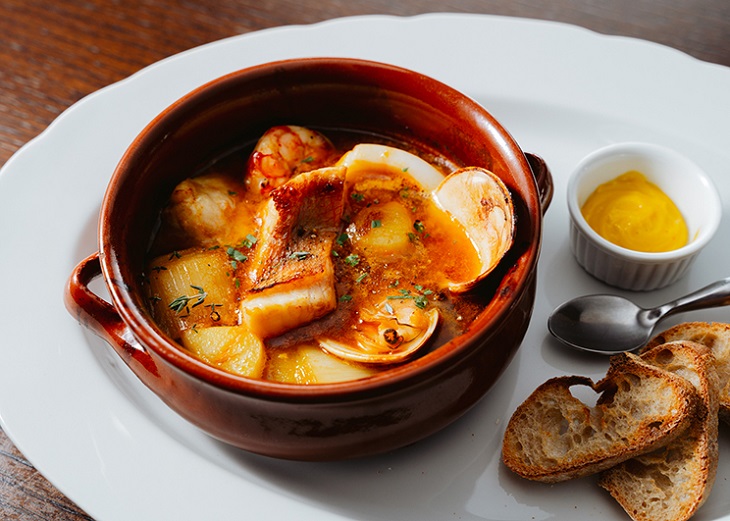
124. KAGURAZAKA
YakitoriThe numbers in the name are both the address of the shop and the birthday of a member of staff. norimaki (bite-size chunks wrapped in nori seaweed) of chicken tenderloin, cooked vegetable salads and deep-fried tofu intersperse the omakase set meal, varying the tone and providing items that pair agreeably with sake.

Fry-ya
TonkatsuSelect the ingredients of your choice and the kitchen will prepare an original ‘mix fry’ just for you.Daytime fare consists of set meals of a variety of items. In the evening, multi-course prix fixe is the theme, with each morsel fried and served fresh.

apothéose
FrenchThe sights, smells, flavours, even the acoustics of the dining room resound with the natural métier of the producing regions.Willingness to experiment, unconstrained by convention, ensures customers understand the joys of food.

Orchestra
ItalianImola, the city in Italy’s Emilia-Romagna where the chef apprenticed, has a famous music academy. The restaurant’s name derives from the passion for classical music he learned from the students he befriended there. Cuisine on plates decorated with musical-instrument motifs and classical music piped into the dining room deliver a performance worthy of any conservatory.

Jfree
French‘Jfree’ means ‘free’ as in ‘free expression’. French cuisine with a healthy dollop of Japanese influence, by a chef well versed in Japanese cuisine.

DepTH Brianza
ItalianChef's latest culinary adventure is a taste test that takes Italian cuisine a little outside its comfort zone. While firmly grounded in tradition, he enjoys reframing Japanese ingredients in creative ways.

Sushidokoro Yamato
SushiOmakase set menus lean towards nigiri, fulfilling the duty of a true sushi restaurant. Rice is seasoned with a mixture of red vinegar and rice vinegar to accommodate a wide range of sushi toppings.

Sushiya Hajime
SushiFish is prepared according to ancient practices such as salting and simmering. Omakase set meals consist of numerous pieces of sushi formed small, affording rich variety and commitment to quality is uncompromising, which is deeply satisfying.

Related articles:
2023: New Additions to the MICHELIN Guide Japan
Illustration image:© Nishitemma Ichigaya



